Patchwork Toolkit - Lightweight Platform for the Network of Things
Patchwork is a toolkit for connecting various devices into a network of things or, in a more broad case - Internet of Things (IoT). A tl;dr picture describing the idea behind it is shown below.
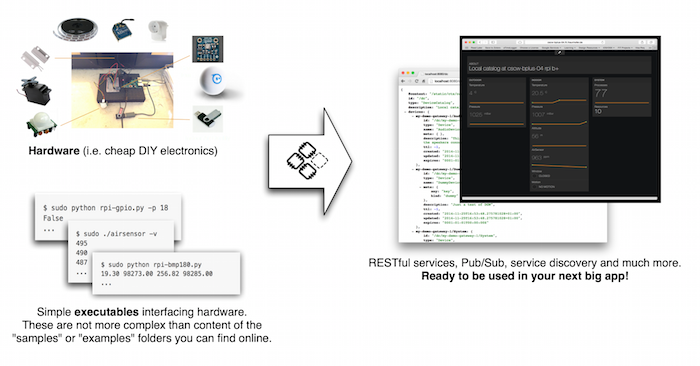
Considering you as a hacker/hobbyist, the Patchwork toolkit can be expressed as follows: you take your favourite electronics (bunch of sensors, LED strip, robot-toys, etc), connect them to a pocket-size Linux box, install Patchwork, and after some quick configuration you get RESTful APIs, MQTT data streams, directory of your devices and services, their discovery on the LAN with DNS-SD/Bonjour, and a damn-sexy, open source real-time dashboard based on Freeboard.
All you need is your creativity: focus on the implementation of your idea, not infrastructure!
Table of contents
Why
The Internet of Things (IoT) is causing a hype all over the Internet, yet implementing even basic IoT scenarios like smart home/office today is still challenging. One of the main challenges is to connect IoT devices (sensors, actuators) to the network and provide access to them for applications using common APIs and protocols.
The IoT devices market is growing, and it is very simple to build your own “sensor platform” for under $100 using a Raspberry Pi and a handful of sensors. Once you have things working locally though, you start running into troubles: how to expose these devices on the network? how to discover and access them to build web/mobile applications to monitor and actuate things? At this point, you basically have two options:
- Write a simple web/ws server and/or setup an MQTT broker (and hard-coded endpoints)
- Find an existing IoT framework/toolkit and integrate your devices/applications with it
Without going into much details, we got tired of doing 1. over and over again, and couldn’t find 2. that would satisfy our expectations in being simple, lightweight, easy to deploy and work with. With these goals in mind, we started creating Patchwork - a lightweight toolkit for IoT development that offers integration of devices through configuration and provides basic services for zeroconf discovery of resources and services on the network.
Architecture
Overview
A bird’s-eye-view of the Patchwork architecture is shown in the picture:
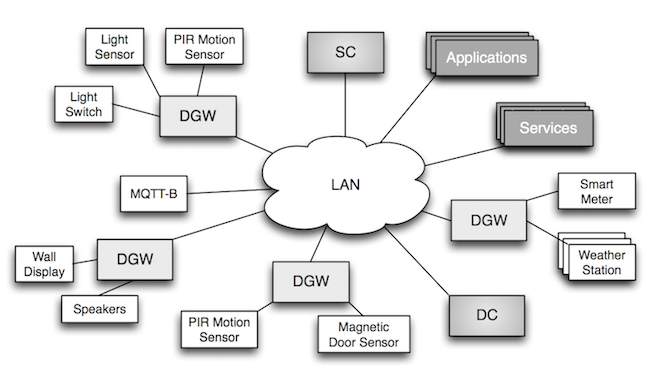
Patchwork integrates devices, applications and services with the help of the following components:
- Device Gateway (DGW) integrates various IoT devices and exposes their resources on the network via common APIs (REST, MQTT)
- Device Catalog (DC) provides a registry of available IoT devices and their capabilities on the network
- Service Catalog (SC) provides a registry of available services (MQTT broker, Device Catalog, DB, …) on the network
Device Gateway
A high-level architecture of the DGW capturing its main modules is shown in the picture:
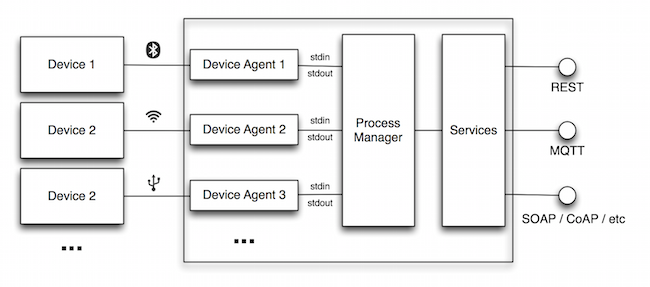
- Devices are connected to the host running DGW and communicate with Device Agents using their native protocols (Serial, ZigBee, etc)
- Device Agents are small programs running on the DGW that communicate with the Process Manager via stdin/stdout
- Process Manager manages the Device Agents (system processes) and forwards data between them and the communication Services
- Services expose the devices managed by Device Agents via common APIs (REST/MQTT) and forward requests/responses and data streams to the applications
Device agents for Patchwork can be implemented in any programming language suitable for integration of a particular device and example agents are provided. Having a device agent, the integration of a new device reduces to describing its capabilities and parameters to the agent and communication protocols in a json configuration file. Using this configuration, DGW will register the device in the Device Catalog and expose its resources via configured APIs.
Discovery
In Patchwork, we distinguish between discovery of network services and IoT devices, which is implemented by the Device and Service catalogs correspondingly. The catalogs serve as registries for both Patchwork components and third-party applications and services and expose RESTful APIs.
Devices integrated with the DGW are automatically registered in its local Device Catalog, which can be used by applications to search for devices integrated with that DGW by their capabilities/meta-information. In addition to that, a network-wide Device Catalog can be configured on DGWs and populated with information about all devices in the network.
Similarly, Service Catalog provides a registry of services running on the network, and can be used by applications to search for services by meta-information. For example, a network-wide Device Catalog can be registered in the Service Catalog to be discovered by applications.
To enable zeroconf networking and discovery of services and IoT devices without manual configuration of the endpoints or IP addresses, we use DNS-SD discovery and advertise the Service Catalog endpoint on the network. Having discovered the Service Catalog, applications can query it for available services and then search for devices by querying the discovered Device Catalog.
Implementation highlights
We’ve chosen Go for implementation for multiple reasons, some of which are described in more details below. Following our basic requirements, we wanted to have static linking and cross-platform builds for simple deployment on pocket-sized computers and development and testing on multiple platforms. Performance and productivity also made a great contribution to our choice: targeting at resource-constrained ARM devices, we wanted to have performance comparable to C and productivity comparable to python. Last but not least, it all started as a spare time project and we wanted it to be fun to work on.
Using Go’s standard library
As already acclaimed by many, the Go’s standard library is very rich and intuitive. Some highlights from our experience:
* net/http was very simple to get started building our http and REST APIs and eventually we ended up with using it almost exclusively. We only took the gorilla/mux package to have a more straightforward router configuration and recently included codegangsta/negroni middleware for future extensions (without changing our handlers as it conforms to the net/http Handler)
* crypto/tls was surprisingly easy (e.g., compared to Bouncycastle in Java) to configure and use TLS sockets (we used that for MQTT)
* net together with golang.org/x/net (where x stands for cool as @Francesc mentioned in his Twitter) helped us write a very rough implementation of the mDNS/DNS-SD standards for services discovery: you can check it out in our Bonjour repository.
Process management
One of the key goals of DGW was executing external programs, which should talk to the hardware resources using a low-level (close to metal) interfaces and protocols and keep the communication with DGW using stdin and stdout streams. These external programs can be executed once upon a request (task), periodically (timer), or can be constantly running and producing output (service).
The idea of how to implement such process management came from Foreman - a Procfile-based applications manager. Luckily, we found 2 ports of this great developer’s tool to Go: Forego and Goreman. In fact, we had the same requirements, but instead of using Procfile we had our JSON-based configuration and the processes had different types of execution.
Communication patterns
Another challenge in creating DGW was how to implement HTTP request processing pipeline: 1. RESTful API handler receives HTTP GET request 2. DGW resolves which agent is exposed under request’s URI 3. DGW invokes a corresponding executable (if it is a task) and captures its standard output stream or reads the latest cached value (if it is a timer or a service) 4. DGW returns the value (or an error) back to the HTTP request handler 5. The handler composes and sends the HTTP response
Or another scenario, which is even more complex: 1. RESTful API handler receives HTTP PUT request, which requires changing the corresponding hardware resource state (using actuator rather than sensor) 2. DGW resolves which agent is exposed under request’s URI 3. DGW invokes a corresponding executable (if it is a task) and writes received PUT data to its standard input stream, then captures its standard output stream. We do not support writes for timer agent types. 4. The rest of the steps are similar to steps 4 and 5 in the previous scenario.
This is where advanced Go concurrency patterns help a lot. Good luck synchronizing your threads when writing it in another conventional language! In our implementation each HTTP handler has access to the agent manager’s inbox channel, which it sends a special request structure to. This special request structure has another channel (read by the handler’s goroutine) so that the agent manager can send execution results back to the handler’s goroutine.
Logging
Similar to other developers coming from other programming languages (Python, Java, etc) we were first uncomfortable having such a ascetic log package in the standard library: hey, where are the log levels?
Disappointed by its austerity we have tried many of the existing clones/ports packages such as log4go, glog and go-logging but after all came back to the standard log and sticked to it for its simplicity. We just implemented a simple wrapper around it to distinguish between logs coming from our different packages/modules. And you know what? We still didn’t run into a severe need of having those logging levels and colourful output in the terminal. Just rely on the famous The Twelve-Factor App methodology (chapter XI. Logs): do leave the task of implying something from your logs to an external tool (which is already implemented) when it bites you.
Dependency management
Reproducible builds and development environment have gotten on our radar when one day we got broken code caused by incompatible changes in the MQTT package. Although we were initially skeptical about vendoring, it does provide clear benefits when building distributed systems and shipping code to constrained devices lacking Internet connectivity - scenarios which are very relevant for what we are doing with Patchwork.
Looking for dependency management and/or vendoring solution, we’ve evaluated several different tools and approaches. We really liked GPM/GVP for their simplicity, but the only cross-platform solution we were able to find was godep. We started using godep by simply fixing the dependencies versions in the Godeps.json and eventually switched to vendoring, which allows us to build patchwork without Internet connectivity.
Cross-platform builds and deployment
Another reason to be happy with Go is a possibility to cross-compile the Go code for different operating systems and processor architectures on the same machine without running a bunch of virtual boxes and custom management of toolchains. Patchwork’s binary release process is blazing fast (running on the 2.7 GHz Intel Core i7 with 8 cores / 16 GB RAM MacBook Pro) and creates executables for OSX (amd64), Linux (amd64, arm) and Windows (amd64) running a single command with the help of Gox, which is a simple, no-frills tool for Go cross compilation that behaves a lot like standard go build, parallelize builds for multiple platforms and also build the cross-compilation toolchain for you.
Usage example
Here we would like to share with you how Patchwork can be used to implement simple smart home/office scenarios. Once you have your IoT infrastructure created with Patchwork, it’s up to you which tools, languages, IDEs to use for hacking into your interconnected hardware. We just give you a couple of suggestions here.
Dashboard out of the box
The dashboard (based on Freeboard) comes out of the box when you run the DGW. This is the simplest thing you can do: connect the hardware, run the Patchwork’s DGW, open a dashboard on your wall-mounted screen and configure a monitoring view for your environment.
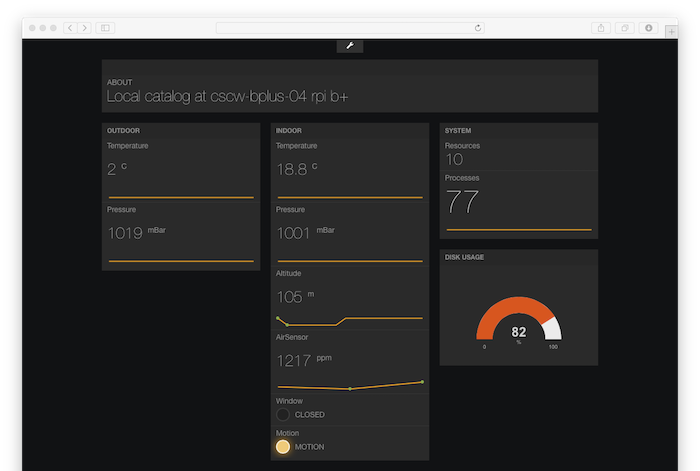
Quick prototyping using IBM’s NodeRed
Observing the sensors values is fun for the first 2 hours, but later you would definitely get an itch to program something sophisticated. Why not trying Visual Programming Paradigm in practice and explore a little bit of Dataflow with the help of IBM’s NodeRed - a visual tool for wiring the IoT?
On the screenshots below you can see 2 flows (this is how programs are called in dataflow programming) we have created within minutes using our Patchwork APIs. The first flow it performing data fusion of three sensors: magnetic window opened/closed sensor, PIR motion sensor and Indoor Air Quality (IAQ) sensor. The combined array of 3 values is passed to downstream only when at least once sensor value changes and the array is published to the preconfigured MQTT broker, exposed also as a service using Patchwork’s SC (Service Catalog).
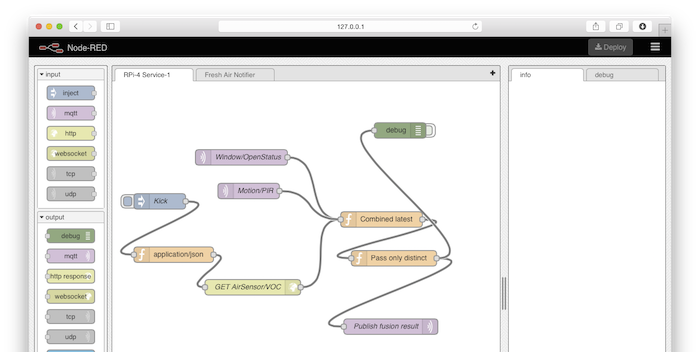
On the second flow we subscribe to the sensor data array, published by the flow described above, and evaluate the following rules: * IF the air quality is bad (for mental work; using constant threshold) AND window is closed AND there is movement in the office THEN pass the data to downstream * otherwise do nothing
The downstream process composes an English sentence that suggests the user to ventilate the room and passes that sentence to the TTS (Text-To-Speech) component and generates a standard OSX desktop notification to inform the user.
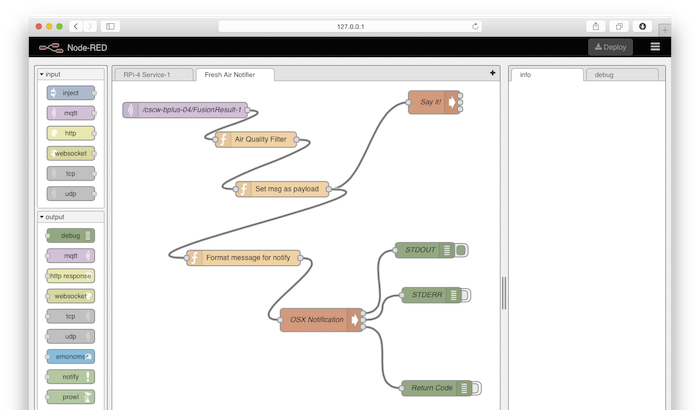
Summary and future work
The current version of Patchwork is completely focused on creating a smart environment within a private network. We are currently exploring different ways to support creation of distributed smart environments and providing different ways to manage the data streams and implement services execution between them.
Additionally, we are working on adding support for more service protocols (CoAP, WebSocket) and data formats to the DGW and catalogs APIs.
